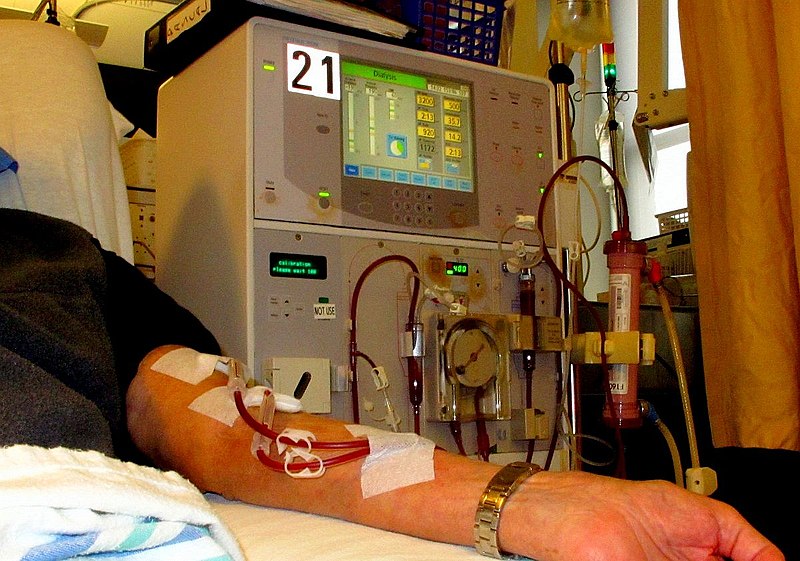What is the Difference Between Apheresis and Dialysis
The key difference between apheresis and dialysis is that apheresis is the process of removing a specific portion of the blood and returning the remainder of the blood to the patient, while dialysis is the process of removing waste products and excess fluid from the blood when the kidneys of the patient stop working properly.
Apheresis and dialysis are two processes involved in removing substances from the blood. Apheresis removes pathological material from the human blood, while dialysis removes waste products and excess fluid from the human blood. Both processes are predominately carried out in the clinical setup.
CONTENTS
1. Overview and Key Difference
2. What is Apheresis
3. What is Dialysis
4. Similarities – Apheresis and Dialysis
5. Apheresis vs Dialysis in Tabular Form
6. Summary – Apheresis vs Dialysis
What is Apheresis?
Apheresis is the process of removing a specific portion of the blood and returning the remainder of the blood to the patient. It is also known as hemapheresis or pheresis. Some examples of apheresis include plasmapheresis (removal of plasma), leukapheresis (removal of white blood cells), granulocytapheresis (removal of granulocytes such as neutrophils, eosinophils, and basophils), lymphocytapheresis (removal of lymphocytes), lymphoplasmapheresis (removal of lymphocytes and plasma), and plateletpheresis or throbocytapheresis (removal of platelets).

Figure 01: Apheresis – Whole blood entering the centrifuge (1) and separating into plasma (2), leukocytes (3), and erythrocytes (4). Selected components are then drawn off (5)
In this procedure, a person’s blood is removed from their arm trough tubing which goes into a cell separator. Then the desired portion is separated from the blood and the remainder of the blood flow backs into the patient again through tubing. In therapeutic apheresis like plasma exchange, if the plasma is removed, then it is replaced with a replacement fluid later. Apheresis is usually performed during blood donation and on patients who have an illness associated with an abnormal cellular or plasma-based blood component.
What is Dialysis?
Dialysis is the process of removing waste products and excess fluid from the blood. It is a type of extracorporeal therapy that takes place when the kidneys of the patient stop working properly. Dialysis often involves diverting blood to a machine to be cleaned. Usually, kidneys filter the blood and remove harmful waste products and excess fluid, turning these into urine to be passed out of the body. In conditions such as chronic kidney disease, kidneys do not function properly. Therefore, waste products and fluid can build up to dangerous levels in the body. Dialysis filters out unwanted substances and fluids from the blood before waste products and fluid build-up.

Figure 02: Dialysis
There are two main types of dialysis: hemodialysis and peritoneal dialysis. Hemodialysis is carried out at dialysis centers by using an external machine. Peritoneal dialysis uses the inside lining of the abdomen called the peritoneum as the filter rather than a machine. Furthermore, peritoneal dialysis can be performed at home quite easily.
What are the Similarities Between Apheresis and Dialysis?
- Both procedures involve the removal of harmful toxic materials from the blood.
- Both are types of extracorporeal therapies.
- Therapeutic apheresis is similar to dialysis.
- They are extremely important for the protection of the human body.
What is the Difference Between Apheresis and Dialysis?
Apheresis is the process of removing a specific portion of the blood and returning the remainder of the blood to the patient, while dialysis is the process of removing waste products and excess fluid from the blood when the kidneys of the patient stop working properly. Thus, this is the key difference between apheresis and dialysis. Furthermore, apheresis is performed during blood donation and on patients who have an illness associated with an abnormal cellular or plasma-based blood component. On the other hand, dialysis is performed on patients whose kidneys do not work properly due to conditions like chronic kidney disease.
The below infographic presents the differences between apheresis and dialysis in tabular form for side by side comparison.
Summary – Apheresis vs Dialysis
Apheresis and dialysis are two important processes involved in removing harmful substances from the blood. Apheresis removes a specific portion of the blood and returns the remainder of the blood to the patient. In contrast, dialysis removes waste products and excess fluid from the blood when the kidneys of the patient stop working properly. So, this is the key difference between apheresis and dialysis.
Reference:
1. “Apheresis.” An Overview | ScienceDirect Topics.
2. “Dialysis.” NHS Choices, NHS.
Image Courtesy:
1. “Apheresis” By Mononomic at English Wikipedia (CC BY-SA 3.0) via Commons Wikimedia
2. “Dialysis – arm – 01” By Anna Frodesiak – Own work (CC0) via Commons Wikimedia
ncG1vNJzZmivp6x7pbXFn5yrnZ6YsqOx07CcnqZemLyue9ahmK1lmah6tbTEZpuinpaav6a6wp5km52krLKmuoyap6GdoprAqr%2BMmqWdZZSerq3F0qKqaA%3D%3D